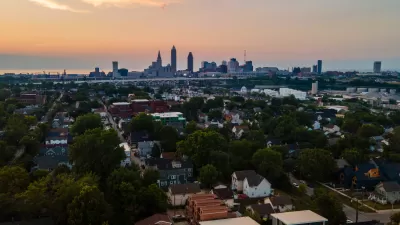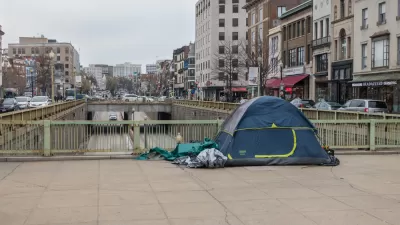A new study highlights the important role of emergency relief funding and eviction bans in stemming the rise of homelessness even as more families became housing-insecure.

Writing in Bloomberg CityLab, Kriston Capps outlines the concerns raised by a new analysis from the U.S. Department of Housing and Urban Development (HUD) that shows how eviction moratoriums and other emergency assistance programs launched during the pandemic helped prevent many Americans from falling into homelessness.
Officials describe this as an under-heralded success story of the pandemic emergency response. It’s also a warning about a still-urgent threat: In the wake of emergency relief efforts, homelessness is rising once again.
The study reveals that the number of households spending over 50 percent of their income on housing—the “worst-case housing needs”—hit a record 8.5 million household in 2021, yet sheltered homelessness decreased by 17 percent between 2019 and 2021. This is due to the “massive intervention” consisting of $47 billion in federal rental assistance and eviction moratoriums that kept many families with precarious housing situations in their homes.
Some key takeaways: “Pandemic interventions demonstrated that it’s possible to combat the routine use of evictions as a rent collection tool by combining legal aid with financial support.” Additionally, “Rapid rehousing, permanent supportive housing and other tools associated with the “housing first” model are the best options for dialing back homelessness, according to the analysis. And above all, homelessness is a housing problem, so building more rental housing at all levels of affordability is key to reducing the problems that lead to displacement.”
The study highlights an urgent warning: As pandemic relief programs end and housing instability remains a growing problem, “worst-case housing needs still represent an emergency.”
FULL STORY: Housing Instability Spiked During the Pandemic. Homelessness Didn’t.

Planetizen Federal Action Tracker
A weekly monitor of how Trump’s orders and actions are impacting planners and planning in America.

Chicago’s Ghost Rails
Just beneath the surface of the modern city lie the remnants of its expansive early 20th-century streetcar system.

San Antonio and Austin are Fusing Into one Massive Megaregion
The region spanning the two central Texas cities is growing fast, posing challenges for local infrastructure and water supplies.

Since Zion's Shuttles Went Electric “The Smog is Gone”
Visitors to Zion National Park can enjoy the canyon via the nation’s first fully electric park shuttle system.

Trump Distributing DOT Safety Funds at 1/10 Rate of Biden
Funds for Safe Streets and other transportation safety and equity programs are being held up by administrative reviews and conflicts with the Trump administration’s priorities.

German Cities Subsidize Taxis for Women Amid Wave of Violence
Free or low-cost taxi rides can help women navigate cities more safely, but critics say the programs don't address the root causes of violence against women.
Urban Design for Planners 1: Software Tools
This six-course series explores essential urban design concepts using open source software and equips planners with the tools they need to participate fully in the urban design process.
Planning for Universal Design
Learn the tools for implementing Universal Design in planning regulations.
planning NEXT
Appalachian Highlands Housing Partners
Mpact (founded as Rail~Volution)
City of Camden Redevelopment Agency
City of Astoria
City of Portland
City of Laramie





























